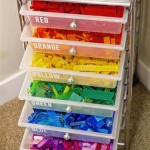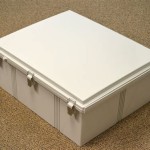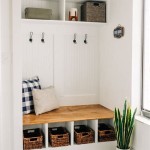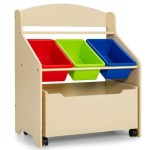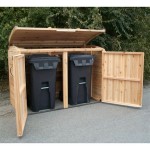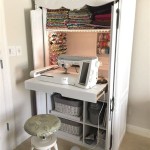Adding Functionality And Beauty With Wood Storage Drawers Shelves
Wood storage drawers and shelves represent a versatile and aesthetically pleasing solution for organizing belongings within a residence or commercial space. Their enduring popularity stems from a confluence of factors, including their inherent durability, visual appeal, and adaptability to diverse design styles. The incorporation of wood elements into storage systems introduces a warmth and organic texture that synthetic materials often lack, creating an environment that is both functional and inviting.
The selection of appropriate wood storage systems requires careful consideration of several parameters, including the intended application, spatial constraints, and desired aesthetic. Understanding the nuances of different wood types, construction methods, and hardware options is crucial for making informed decisions that yield long-term satisfaction. This article explores the various aspects of integrating wood storage drawers and shelves into a space, highlighting key considerations for achieving optimal functionality and visual coherence.
Understanding the Properties of Different Wood Types
The choice of wood for storage drawers and shelves significantly impacts the overall durability, appearance, and cost of the system. Different wood species possess unique characteristics that render them suitable for various applications. Hardwoods, such as oak, maple, and cherry, are renowned for their strength, density, and resistance to wear and tear. These qualities make them ideal for high-traffic areas and items subject to significant weight or stress. Softwoods, including pine, fir, and cedar, offer a more economical alternative while still providing adequate structural integrity for many storage needs. Furthermore, softwoods often feature a distinctive grain pattern that can enhance the visual appeal of the storage system. The suitability of a particular wood type also depends on the environmental conditions in the space where it will be used. For example, cedar is naturally resistant to moisture and insect damage, making it a preferred choice for closets and humid environments.
Oak, a popular hardwood choice, is known for its exceptional strength and distinctive grain pattern. It readily accepts stains and finishes, allowing for a wide range of aesthetic possibilities. Maple offers a smoother, more uniform grain compared to oak, and its light color provides a neutral backdrop that complements diverse interior design schemes. Cherry, characterized by its rich reddish-brown hue, adds a touch of elegance and sophistication to any space. Pine, a softwood commonly used for shelving, is readily available and cost-effective. Its knotty grain pattern imparts a rustic charm, making it well-suited for casual or country-style interiors. Cedar, with its aromatic scent and natural insect repellent properties, is a practical and aesthetically pleasing choice for closet storage. When selecting a wood type, it is imperative to consider both its aesthetic qualities and its functional suitability for the intended purpose of the storage system.
Beyond the specific species, the grade of the wood also warrants consideration. Higher-grade lumber will have fewer knots and imperfections, resulting in a cleaner, more consistent appearance. Lower-grade lumber may be more economical but may require more extensive preparation and finishing to achieve the desired aesthetic. The choice between solid wood and engineered wood, such as plywood or MDF, also influences the durability and cost of the storage system. Solid wood offers superior strength and longevity, while engineered wood provides greater stability and resistance to warping.
Designing Functional and Aesthetically Pleasing Storage Drawers
The design and construction of wood storage drawers are critical for ensuring both functionality and visual appeal. The dimensions of the drawers should be carefully considered to accommodate the items to be stored. Deep drawers are suitable for bulky items such as linens or sweaters, while shallow drawers are ideal for smaller items such as socks or jewelry. The internal organization of the drawers can be further enhanced by incorporating dividers, trays, or specialized inserts. These features help to keep items neatly organized and easily accessible.
The method of drawer construction significantly impacts its strength and durability. Dovetail joints, renowned for their interlocking design, offer exceptional resistance to racking and pulling forces. Dado joints provide a strong and stable connection between the drawer sides and bottom. Rabbet joints, a simpler alternative, are often used for less demanding applications. The choice of drawer slides also influences the smooth operation and weight capacity of the drawers. Ball-bearing slides offer superior performance compared to friction slides, allowing for effortless opening and closing even when the drawers are fully loaded. Soft-close mechanisms provide a refined and user-friendly experience, preventing the drawers from slamming shut.
The aesthetic design of the drawer fronts plays a crucial role in the overall appearance of the storage system. Raised-panel drawer fronts add depth and dimension, while flat-panel drawer fronts offer a clean and contemporary look. The choice of hardware, such as knobs or pulls, further contributes to the aesthetic. Metal hardware imparts a modern and industrial feel, while wooden hardware complements a traditional or rustic style. The finish applied to the drawer fronts should be chosen to complement the surrounding décor and protect the wood from moisture and wear. Paint provides a durable and versatile finish, while stain enhances the natural grain pattern of the wood. A clear topcoat can be applied over either paint or stain to provide added protection and a subtle sheen.
Optimizing Shelf Design for Various Storage Needs
Wood shelves provide a versatile and efficient means of organizing and displaying items in any space. The optimal shelf design depends on the intended use of the shelves, the weight of the items to be stored, and the aesthetic preferences of the user. Shelf thickness is a critical factor in determining the weight-bearing capacity of the shelves. Thicker shelves can support heavier loads without sagging or bowing. The spacing between shelves should be carefully planned to accommodate the height of the items to be stored. Adjustable shelves offer maximum flexibility, allowing the user to customize the shelf configuration to suit their changing needs.
The method of shelf support influences both the structural integrity and the visual appeal of the shelving system. Shelf brackets provide a simple and cost-effective means of supporting shelves. Floating shelves, which appear to be suspended without visible supports, offer a clean and minimalist aesthetic. Built-in shelves, integrated directly into the wall, provide a seamless and permanent storage solution. The choice of shelf material also impacts its durability and aesthetic. Solid wood shelves offer superior strength and longevity, while engineered wood shelves provide greater stability and resistance to warping. Glass shelves, while not made of wood, can be incorporated to create visual interest and allow light to pass through the shelving system.
The finish applied to the shelves should be chosen to complement the surrounding décor and protect the wood from moisture and wear. Paint provides a durable and versatile finish, while stain enhances the natural grain pattern of the wood. A clear topcoat can be applied over either paint or stain to provide added protection and a subtle sheen. Consider the placement of lighting to further enhance the aesthetic appeal of the shelving system. Under-shelf lighting can illuminate the items on display, creating a dramatic and inviting ambiance. Recessed lighting can be used to highlight specific areas of the shelving system, adding depth and dimension to the space.
The integration of wood storage drawers and shelves is not merely about providing storage space; it is about enhancing the overall aesthetic and functionality of a room. Thoughtful planning and execution are essential for creating a storage system that is both visually appealing and highly practical. By carefully considering the properties of different wood types, the design of the drawers and shelves, and the overall aesthetic of the space, one can achieve a storage solution that meets their specific needs and enhances the beauty of their home or office.

Creative Bathroom Storage Ideas Efficient Effective

Creative Storage Solutions Maximizing Space With Smart Design

10 Great Built In Bathroom Storage Ideas To Consider When Building A Luxury Home Suzette Gebhardt

25 Clever Bedroom Storage Ideas To Keep Your Space Organized

Contemporary Wooden Study Desk With Shelves Drawer And Curved Design For Modern Spaces Sona Arts

Fufu Gaga White Makeup Vanity Desk 9 Drawers Wood Dressing Table With 3 Led Bulb Light Mirrors Glass Top Storage Shelves Kf210213 04 The Home Depot

Softel Handcrafted Kitchen Organizer With Drawer Storage Rack Shelf Wooden Living Room 1 Pc

Fufu Gaga 5 Drawers White Makeup Vanity Table Wooden Dressing Desk With Mirror And 3 Tier Storage Shelves 55 1 X 31 15 7 In Kf210106 01 The Home Depot

Tidy Up With These Beautiful Bathroom Shelf Ideas Curbly

How To Design Your Dream Pantry Even If You Re Short On Space
Related Posts

